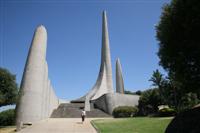
The Afrikaans Language Museum pays tribute to a unique language that is little more than 300 years old. Created from the melting pot of languages in the Cape, Afrikaans developed from the need of Dutch settlers, French Huguenots, slaves from Malaysia, Indonesia, Madagascar, and West Africa, and the local Khoi people to communicate. The struggle to gain recognition of Afrikaans as an official language was carried out from Paarl, and the museum commemorates the people that played an important role in the process. The institution also explores the language in its diversity. Conspicuously absent from the material is the integral role Afrikaans played as the language of the apartheid oppressors. The Language Monument on Paarl Mountain was erected in 1975 to honour the Afrikaans language and is the only language monument in the world. The contribution to Afrikaans from the Western world, as well as from Africa, are represented by the three linked columns and three rounded shapes respectively, while the 187 foot (57m) pillar symbolises the growth of the language. There are beautiful views from Paarl Mountain, where the monument is situated.
Address : Museum: Gideon Malherbe House, 11 Pastorie Avenue, Paarl. Monument: Paarl Mountain
Website : www.taalmuseum.co.za
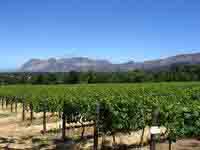
Constantia is the origin of wine production in South Africa, and one of Cape Town's most exclusive suburbs. The Constantia wine route is the oldest yet smallest wine route in the Cape, consisting of just five wine farms that concentrate on producing a few wines of international quality and repute. The historic Cape Dutch homestead at Groot Constantia is one of the oldest wine estates in South Africa, home to the first governor of the Cape, Simon van der Stel, and the valley's most famous wine farm. The house itself is furnished with items from the period, while an adjacent wine museum exhibits drinking and storage vessels in glass, silver, copper, and stoneware dating from 500 BC to the 19th century. There are some great restaurants at Groot Constantia as well as tasting rooms. Visitors are welcome to wander around the beautiful estate. The other four wine estates that are generally known to constitute the Constantia wine route are Klein Constantia, Steenberg, Buitenverwachting and Constantia Uitsig, all of which include highly acclaimed restaurants.Those who want to extend their route further can also explore Beau Constantia, Constantia Glen, Eagles' Nest and Silvermist Wine Estate. Meandering from one estate to another in Constantia is a glorious way to spend a day, complete with history, natural beauty, great food, and, of course, superb wine.
Website : www.constantiawineroute.com
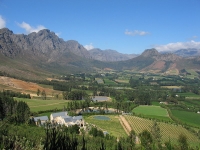
Fleeing religious persecution in France in the 1700s, more than 200 French Huguenots arrived in the Cape and were settled in the valley that soon became known as Franschhoek (French Corner), which is today situated in the heart of the Cape Winelands region. Many of the settlers were experienced wine producers and they soon recognised the potential of the region for wine and fruit production, establishing wine estates throughout the spectacular Franschhoek Valley in surroundings of magnificent scenery and towering mountains. Today the town is famous not only for its splendid wines and beautiful vistas, but also as the gourmet capital of South Africa, boasting the highest number of award-winning eateries in the country. Restaurants such as Le Quartier Français, La Petite Ferme, Haute Cabriere, and Boschendal are among those that are internationally acclaimed. The Huguenots also left behind a rich legacy of arts, architecture, and hospitality, which are still visible today. Franschhoek hosts a number of wonderful festivals, including a book fair, a big celebration for Bastille Day, and champagne and wine tasting festivals.
Website : www.franschhoek.org.za
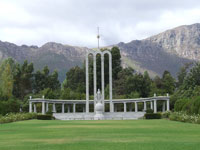
The historic Huguenot Monument was erected in 1945 and is a major tourist attraction in the Franschhoek Valley. It commemorates and honours the French Huguenots who arrived in South Africa in 1688 after fleeing brutal persecution in their home country. The nearby museum documents the history of the settlers, from their flight from France to their arrival and successful establishment of the Franschhoek wine region in the Cape of Good Hope. The little museum contains a variety of Bibles, documents, furniture, utensils, and artefacts, providing insight into the life of the Huguenots in the Cape. The memorial is graceful and the calm of the place is moving, considering the violent history of the fleeing Huguenots. The three high arches symbolise the Holy Trinity. The sun rising above them represents righteousness, and the cross represents the Huguenot's Christian faith. The central female figure personifies religious freedom, with a Bible in one hand and a broken chain in the other. For any visitor interested in the history of French settlement in South Africa, or in the history of the beautiful Franschoek Valley in general, a visit here will be rewarding.
Address : Franschhoek
Website : www.museum.co.za
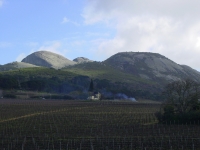
Paarl is built in the picturesque Berg River Valley, which lies at the foot of the second-largest granite outcrop in the world. It is the biggest town in the Cape Winelands and the third oldest European settlement in South Africa. Paarl features some of the most superb examples of Cape Dutch, Victorian, Edwardian, and Art Deco architecture in the country. Its rich history includes Drakenstein Prison, where Nelson Mandela spent his last years in captivity. The Language Monument overlooks the town from the slopes of the Paarl Mountain, and symbolises the birth of the Afrikaans language. Along with its historical background, Paarl is also known for its award-winning wines, particularly its reds, which can be sampled along one of the world's first 'Red Routes'. Paarl's wine route includes more than 40 cellars, among them Nederburg and KWV. Many of them also make a variety of delicious cheeses. Paarl Mountain, or Paarl Rock, looms above the town and is sometimes compared to Ayers Rock in Australia, although geologically they are very different. The rock is popular with climbers, but the routes are difficult and should not be attempted by the inexperienced. There are also many hikes and scenic drives in the verdant natural surroundings.
Website : www.paarlonline.com
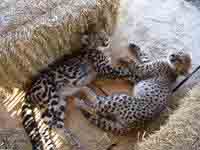
Spier is one of South Africa's most famous and most popular wine estates. Internationally renowned as cultural resort, it offers luxurious accommodation, conference facilities, shopping, fine dining, and a variety of recreational activities, including golf, horse riding, picnics, and a cheetah park. Travellers can visit Eagle Encounters, where they can get up close to some amazing birds of prey. An outdoor amphitheatre traditionally presents a variety of music, theatre, and dance during the Spier Summer Arts Season, seeking to promote, showcase and develop emerging South African talent. Situated in the heart of the Stellenbosch winelands region, Spier also boasts world-class wines in what is the oldest working cellar in South Africa. If that is not enough, Spier claims to have one of the most extensive collections of contemporary art in the country as well. Together with its other facilities, this is one of the most unique developments in the wine world.Spier makes a great base for those wanting to explore the region, with a number of other wonderful wine estates nearby. It is also extremely pleasant to just visit for some wine tasting or a picnic in the lovely grounds.
Address : R310 Lynedoch Road
Website : www.spier.co.za
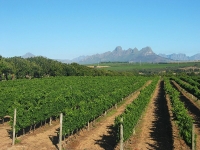
At the heart of the wine industry is the pretty town of Stellenbosch. Along with being the second oldest town in South Africa, it is regarded as the country's wine capital, with over 110 cellars in the area. The Stellenbosch vineyards were established by the Dutch governor of the Cape, Simon van der Stel. He arrived in 1679 and noted that the combination of rich soil and ideal climate were perfect for viticulture. In 1971 the first wine route in South Africa was opened, and today the Stellenbosch wine route is perhaps the best known and finest that the country has to offer. It produces award-winning wines from estates such as Morgenhof, Kanonkop, Warwick, and Zewenwacht. Spier Estate is renowned as a unique cultural resort that is famous for its Summer Arts Festival, and boasts the oldest working wine cellar in the country. Stellenbosch is also steeped in South African history and Afrikaans culture and was settled by the Dutch East India Company to produce food for passing ships.Old oak trees line the streets where Cape Dutch architecture, museums, and national art collections are a reminder of the town's heritage. The town also boasts the world's only Afrikaans university. The premier educational institute has produced many great sporting heroes, including many Springbok rugby players.
Website : www.stellenboschtourism.co.za

Travel Guide powered by Word Travels, copyright © 2023 Globe Media Ltd. By its very nature information in this travel guide is subject to change at short notice and travellers are urged to verify information on which they're relying with the relevant authorities. Neither Globe Media Ltd nor Travel Vogue can accept any responsibility for any loss or inconvenience to any person as a result of information contained above.